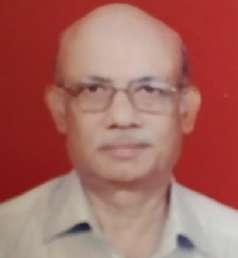
18 minute read
RESEARCH PAPER
THE CAUSES AND REMEDIES OF THE LOOP FORMATION IN FDY
PRATYUSH PUSHKER B. BASU
Advertisement
Author
Department of Textile Technology, VJTI, Mumbai Guide
[1] Introduction
One of the professionally managed group of companies situated at Silvassa who manufactures and bulk continuous filament (BCF) yarns, such as air twisted, power heat set/Superb heat set, cabled/twisted, and air entangled yarns etc., conventional dyed and textile yarns, including partially oriented, fully drawn, draw textured, highly oriented, mono, mother FDY, and air textured yarns having turnover more than 2800 CR, faced the problems of Loom formation in their FDY Product. Hence this Small Project work was assigned to us and was solved with proper studies with suggestions. Loops are always harmful for any industrial product such as POY, FDY, PTY and Twisted yarns as it causes obstacles in the next process especially at the loom stage. It created end breakages, fabric defects and production loss at final stages.
[2] Aim of the Project
Nowadays the end use of FDY is increasing at every stage of twisting, weaving (warp & Weft) knitting (Warp & Circular) and also being used at apparel, Technical Textile, Industrial Textile etc because of its several positive points. Loop formation is very common in POY, FDY .DTY because of the several reasons and of course it is very much harmful. It creates obstacles in warp, weft, knitting processes that go for uneven tension creation, yarn breakages and fabric defects. This paper is specially discussing the loop formation in FDY and suggested the preventive measures and how to minimise the same. Our client organisation was facing this problem mainly in bright FDY and this study was taken. We have checked the production processes, Process control activities and after studying at Length, we derived some conclusions.
[3] What is Fully Drawn Yarn? (FDY)
Fully Drawn Yarn (FDY) is produced by spinning the yarn at higher speeds coupled with intermediate drawing integrated in the process itself. This allows stabilization through orientation and crystallization. Fully Dawn Yarn is used as weft or warp during weaving. It can also be knitted or woven with any other filament yarn in order to produce different varieties of fabrics such as home furnishing fabrics, fashion fabrics, terry towels etc.
FDY is available in 3 lustres, Semidull, Bright having circular section & Trilobal Bright having triangular cross-sections. Instead of making the fabric with FDY Raw-white first & then dyeing it, Dope Dyed Fully Drawn Yarn can be used to make the coloured fabric directly. Fully Drawn Yarns are produced by a continuous polymerisation process. All critical yarn properties such as tenacity, elongation, Uster variation and boiling water shrinkage, intermingling are closely monitored and controlled. Controlled interlace enables the yarns to be twisted or sized in subsequent operations.
FDY has the following properties 1. Intermingled FDY yarns are suitable for direct twisting, warping and weaving. 2. The fabric made from these yarns have a feel and drape similar to fabrics produced from pure silk resulting in high realization of product quality. 3. These yarns eliminate the drawtwisting and sizing process reducing the cost of products for light and medium range fabrics.
4. There is high efficiency and low breakages in subsequent processes. 5. Having excellent dyeing consistency.
[4] Manufacturing Process FDY
The Raw material i.e. PET Chips are dried, melted, filtered and then distributed to spinning manifolds followed by spinning position to get fully drawn yarn. To manufacture FDY, PET chips are fed into a dryer where the moisture is reduced from 0.30% to 0.0020%. After this, chips are melted, filtered through a polymer filter and extruded through the spinnerets. Extruder is electrically heated microprocessor temperature controlled and screw speed is controlled and monitored very precisely to ensure uniform quality. The extruded filaments are cooled by filtered air in the quench chamber with precise temperature control. Air having no turbulence is used to ensure perfect evenness. High quality anti static lubricating oil is applied to avoid static charges in the yarn. The yarn is taken through heated godets to maintain residual elongation. Air punching is done at regular intervals by intermingling nozzles and finally wound on automatic winder in the take up. The FDY so made is capable of running in high speed warping, sizing, knitting, circular knitting and looms.
[4.1] Spinning Speeds
The type of yarn produced during melt spinning is decided by the spinning speed. Low oriented yarn (LOY) is produced at speeds below 1500 m/min. Medium oriented yarns (MOY) are spun between 1500-2200 m/min. partially oriented yarn (POY) is spun at speeds between 2800 to 3600 m/min., where the yarn is more oriented with a little crystallinity. This gives POY better stability, and therefore, POY is preferred as commercial intermediate for drawn or textured yarns. The take up speed of FDY is kept 4000 – 5200 mpm. The take up speed of PA-6 and that of PA-66 is maintained 4000 – 4300 mpm. Yarn made at speeds of 4000-6000 m min is called highly oriented yarn (HOY). It is not fully oriented and has elongation-to-break values of between 40 and 60%. In order to obtain fully oriented yarn (FoY) by a One-step process, with elongation-to-break values of 20-30%, spinning speeds of well over 6000mmin would be needed.
HOY& FOY are manufactured for the Industrial purpose such as High tenacity Yarn, Tyre Cords, Seat belts, Geo Fabrics etc. Normal Partially Oriented Yarn (POY) needs to be necessarily texturised before being used for making fabric whereas FDY is drawn fully during the process of spinning itself and therefore does away with the requirement of texturising and can be used directly for making fabric. FDY is generally used for better quality fabric as the process of texturing is avoided where the bulk yarn is produced.
The flow diagram of the Extruder spinning system is shown for the POY, FDY and Modern FDY. The difference between POY & that of FDY lines is that in FDY there are two additional Godets to draw the yarn, (Please see picture 2 next page). In case of Semi Dull, Bright yarn or super bright yarn, the Master Batch Charging will be eliminated. Master batch is attached only when the Dope Dyed Yarn is produced.
For the CP Line (Continuous polymerisation, without batch Process), the Flow of the melted polymer will be started from Manifold / Polymer Transfer Line and thereafter till the take up zone.
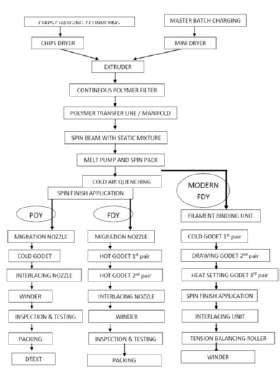
Figure 1: Flow Diagram of Extruder Spinning System Figure 2: FDY Manufacturing Process with multiple Godets from a Batch Processing System
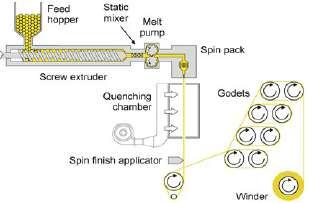
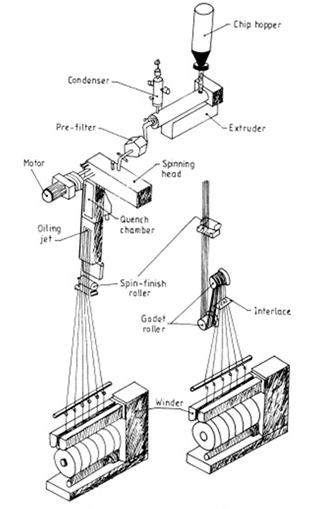
Figure 3: Spinning process without Godet (POY) and with two pair of Godets for the FDY Manufacturing process
[5] WHAT IS LOOP?
When bunch of filaments running together and if one filament gets switched or slacked it forms a loop. Loop is bubble like structure that forms on yarn structure due to the lack in MELT SPINNING process which results in a faulty package and further will result into a faulty fabric formation.
When a yarn is twisted and then woven it will disturb the neighbouring yarn and when the shed is open it will affect the neighbouring yarns and will cause an uneven surface or a faulty fabric. Hence it is not at all desirable. It hampers the quality of the product as well as its aesthetic properties.
[5] What is LOOP?
When a bunch of filaments run together and if one filament gets switched or slacked it forms a loop. Loop is bubble like structure that forms on yarn structure due to the lack in MELT SPINNING process which results in a faulty It is a chronic problem in Nylon POY. It differs from 0.5mm, 1mm etc. However during the production process of FDY due to any lacuna in technical or human process there are chances of loop formation on the surface of the yarn causing irregularities on the surface and stated as a yarn defect. This paper helps in identifying some certain reasons of loop formation and its prevention.

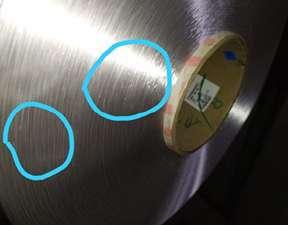
Figure 4: Loops in the FDY Packages:
[5.1] CAUSES OF LOOP FORMATION -
1. Due to variation in air pressure or if jet is not regular - eg - Air with angle 90° will have more loops than 80° (chances will be more if the flow is from up to down) or if in the quenching chamber the air flow is from a single direction only.
If there is choke up in the jet application. 2. Loops can come from Spinneret -
Due to irregularities in the holes caused by the accumulation of particles. And if the holes are not as per the yarn denier. 3. Loops can also be generated due to irregularities of Spin Finish application as lesser the Spins higher will be the loop. 4. Difference in yarn diameter to that of nozzle diameter also results in loop formation. 5. Loops generate if zone temperature is not set properly, or quench air flow is not set according to yarn denier & individual filament denier.
6. Variation in process parameters (like variation in speed or jerk in yarn) also results in loop formation.
7. Loops can come from guides in the take up area, or from air nozzle & intermingling, and from winter during the traverse motion. 8. In Trilobal Spinning there is a higher chance of getting a loop due to the irregularity in the arrangement of filaments.
Figure 5: Spinning Area
Figure 7: Guides in take up area (godet) 9. It could be due to grooved drum, spinneret, and traverse guide
[5.2] Precautions to prevent LOOP formation -
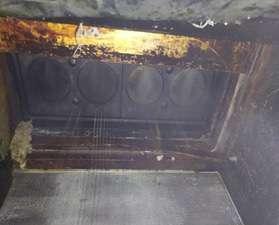
1. Nozzle Air pressure and its angle should be maintained properly and as per requirement. Air should not contain any moisture i.e. it should be dry and should be neutral in behaviour that it should not affect the yarn quality. Nowadays companies are using machines in which air comes from all the peripheral directions of the quenching chamber. 2. SPINNERET should be inspected on a regular basis and before passage of yarn air with high pressure should be passed through it so that particles accumulated at its holes get passed away. The Spinneret holes should be used according to the yarn denier to be processed. Spinnerets should be arranged in such a way that all the filaments
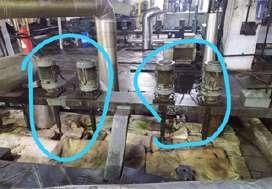
Figure 6: Gear Pump Motot

Figure 8: Extruder
should touch each other equally. 3. Arrangements of Spins should be regular and it should be inspected on a regular basis as if it get loose it will result in formation on bigger loops. 4. Ratio of Yarn dia. to Nozzle dia. should be as per measures as it may also result in deterioration of yarn surface and behaviour. 5. Zone temperature should be maintained properly and it should not fluctuate and quench air flow should be set according to yarn denier & individual filament denier generally the zone temperature is maintained on 19°C - 22°C.
6. There should not be variation in speed or jerk in yarn due to machine vibration or human error.
7. Guides in the take up area, or air nozzle & intermingling, and winder should be inspected on a regular basis and should be kept dirt free and also if there will be any crack or irregularity on the surface it should be immediately replaced. 8. There should be a proper arrangement of filaments in the Trilobal
Spinning i.e. filament should be adjusted in such a way that there should not be any slippage between them and they should hold each other properly. 9. 9. The arrangement should be in the opposite direction to each other like the top portion of one triangular filament should touch the bottom portion of another one so that the inter cohesion property increases and the arrangement will be regular. 10. To avoid loops in the packages, check the groves of the drum, fix
TG properly, change pack etc. Hence there should be Proper Process control to prevent the occurrence of any Loop Formation.
[6] What is Process Control?
A process Control means that a Process has a minimum amount of variation and to meet the target value without loss of any material and manpower. Increasing Transparency and Confidence through Real-Time Data Sharing Process Control Systems (PCS), sometimes called Industrial Control Systems (ICS), function as pieces of equipment along the production line during manufacturing that test the process in a variety of ways, and return data for monitoring and troubleshooting. Many types of process control systems exist, including Supervisory Control and Data Acquisition (SCADA), Programmable Logic Controllers (PLC), or Distributed Control Systems (DCS), and they work to gather and transmit data obtained during the manufacturing process. A process being in control and meeting customer satisfaction.
As stated a process is in control if it is between the UCL and LCL lines. This just means that the process is working well without much noise.
To meet customer satisfaction we need to check the “process capability.” Process capability checks to see if the process meets some target value (i.e. customer satisfaction line). It starts from the incoming of Raw materials to outgoing of finished goods.
[6.1] The Process Control System in a FDY Plant
To check all the parameters as decided to achieve the desired quality and to see that there is no down gradation. The parameters are (i) Take up Speed which is for a Barmag Winder 4500 mpm, and for coloured yarn it is 4100. The speed is also decided as per the yarn denier. It is checked every day and no variation is allowed. For any nonconformities, the winder is rectified.
(ii) For the China made winters, the take up speed is decided at 4200 mpm. Godet, Zone Tempt and Special Beam temperature to be checked at desired frequency. No variation is permitted. The Godet Temp is kept 160 – 175 degree depending on Den & Filaments. Air flow, moisture contents are to be checked and frequent intervals. Doff weight is checked and that should be uniform as it is auto doffing.
Spinnerets are checked at any Change over of the product.
Cross sections are checked with filament counting of the FDY of the first doff after change over. Take Down is done for the fresh doff and the subsequent doffs at regular intervals. For any non-confirmation the material is downgraded and the actions are taken so that the next doff is produced with uniform dye uptake. The Mergability checking is done for the product of new Pack vs Old pack. The Spin Finish / OPU application is checked every day by the Instrument and for any variation, it is rectified then & there. The measurement of Spin Finish% application is done in Computerised way and the results are displayed after taking the print out. The target spin Finish % (0.95%- 1.0%) kept as per the lustre of the FDY. The Physical properties ( Den, tena, E%, nips per mtr, SH% ) are checked at regular interval say position no 1,2,3 at 1st shift , 4,5,6 and 2nd Shift, 7,8, 9 at 1st Shift Next day and 10,11,12 at 2nd shift and so on. For any abnormalities at any position, all the positions right from 1 to 12 are checked and rectified.
B.F and Loops are checked after focusing light on the spools after doffing and the immediate actions are taken by stopping the winder. All the guides are checked on the machine during running condition every day and also during mc. stoppage. Any non-conformation is rectified immediately. Yarn path, thread to guide, yarn contact paths are checked every day with focussing on the mc. and steps are taken.
BF Formations can be due to capillary break, Spinnerets not clean, bad yarn to metal contact, POY self-life expired, broken/old guides etc. Loops can be formed because of any uneven spin finish application( it is much sensitive in bright yarns), yarns getting any uneven pull during pro-
cessing, any smallest scratching on any metal surface, guide not set properly, old guide with rough surface, Disturbance in the Air flow process, pack life is more etc.
[7] THE RANGE OF FDY PRODUCTION AVAILABLE AS ON TODAY ( APRIL `21)
The Product range of FDY is increasing day by day as per the demand in the market . It has got more demands for the furnishing and Industrial uses .There are high tenacity FDY produced for the sewing thread , Fishing nets, Conveyor belts etc. Below table no 1 is explaining the details. Table 1. Summary: The Denier Range: 30 to 600, Filament Range: 12 to 192. Lustre: SD, Bright, Super bright, Dope Dyed, Mix Cross Section etc. End Usage of the FDY Products as on today : (i) The lighter den 49 , 50 , 47 are used for Warp knitting to produce Net Fabrics , Maharani , CanCan fabrics etc. (ii) The lighter deniers below 80 are used for Saree , Dress materials, Garments , Taffeta Etc (iii) Taffeta is also manufactured by 100 den. (iv) 100 + deniers are used for manufacturing Blankets , Furnishing Fabrics, seat Belts etc. (v) 150 -200 deniers are used for Home Décor , embroidery, etc (vi) coarser deniers i.e. 300+ are used for Industrial products i.e. Fishing nets, road constructions, Built Tech , etc. The chances of loop formation are in SBT, high no. of Filaments, cationic.
[7.1] Physical Properties of the FDY :
Tenacity : 4.0 to 4.5 g/den , High Tenacity : 5.5 – 6 g/den , Elongation % : For knitting – 22-23%, Weft use high speed 23 -24% , Warp use : 24-26% , Good for twisting – 26-28% , Intermingling – 6-7 per mtr for knitting, 12-14 per mtr for weft use. 20- 22 per mtr for warp use. Oil Pick Up – 1%, for Dope dyed / CD – 0.7 – 0.8%. SH% - 5.0 – 7.0%
[8] Quality check procedures Raw Material Inspection
Incoming polymers and chemicals are tested for critical properties before approval - the FIFO system also traces back suppliers' batches and processing performance.
100% Physical Inspection

Table 1
A robust product clearance system at each inspection stage allows only approved packages to move ahead for delivery.
Online Monitoring
Process parameters are passed through a Supervisory Control & Data Acquisition System (SCADA) for immediate rectification of deviations, strengthening of quality, controlling generation of non-standard products and online trend analysis.
Process Control
This streamlines processes, ensures a proactive work system using control charts and statistical tools, counters deviations from ideal norms, and eliminates repetition and non-conformation to parameters during manufacturing of yarn packages.
Final QC Approval
Conforming to Acceptable Quality Limits (AQL), this improves quality measures to meet customer expectations - in service, product and experience.
[9] Action plan
Proper process control at every stage right from POY to Take-up is to be followed vigorously. At every stage proper observation, supervision, visualises are to be there. Periodic maintenance of each and every guide, yarn to metal contact, surface applicants are to be supervised strictly. After doffing of FDY spools, each and every spool has to be checked and inspected thoroughly with the help of power (more focusing on them). Positions are to be noted and actions are to be taken immediately. Every day, with the help of 'STROBOSCOPE' all the winder speed are to be checked as well as the surface and speed of winder is to be inspected for any abnormalities i.e. loop formation, b.f's (broken filament) etc.
Operators are to be kept vigilant to make sure that no abnormalities are to be carried in the process. Pack pressure, pack life are to be controlled as per the schedule. Any expired pack life should not be entertained.
Pack formula is to be strictly as per the denier, number of filaments and shade of the POY. In case of coloured yarn (dope dyed), pack formula should be more vigorous. Humidification in the hall/working
The quenching, airflow, airflow temperature is to be maintained as per the denier, number of filaments and shade of POY.
Temperature monitoring at every stage especially in Godets are to done at every shift of 8 hours
[10] Fish Bone Analysis
(i) The fishbone diagram is a tool that is used to conduct a cause and effect analysis for a particular problem that needs a solution. (ii) Overall, fishbone analysis entails brainstorming to identify various causes of a problem instead of settling with the obvious ones. (iii) Moreover, the fishbone analysis helps to educate the entire team in problem resolution. (iv) Also, they can use it to have their focus on the current issue.

The fact that it uses visuals makes it easier to brainstorm and makes it an essential tool in achieving corrective actions.
[11] Conclusion
By the end of this paper we can now depict the preventive measures for loop formation. This paper highlights most of the process lacks which cause loops in the yarn. This paper also contains the Process Control Systems in the FDY plant and the Quality Check Procedure for FDY yarn. Although it's difficult to maintain the quality of a product over a period of time as the machine parts also get wear and tear and it's not necessary that the quality at starting of the process will remain the same over a longer period. So it is required and suggested to follow proper inspection rules with certain specified guidelines so that there should not be any diversity in the required specifications.
It will not enhance the product cost but the quality of the product will be maintained and the rise in price of the process can be maintained by the measure decrease in formation of faulty yarn packages.











